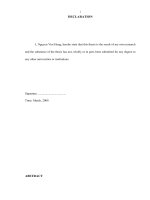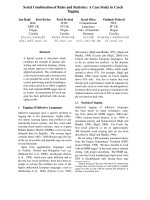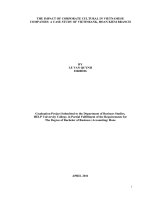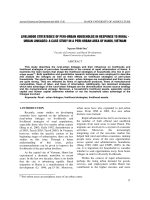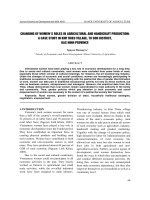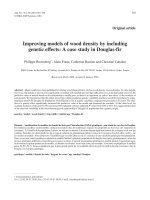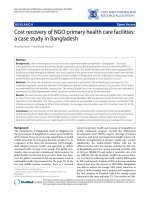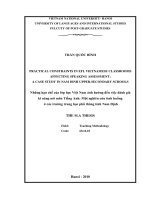Summary of Doctoral thesis: Factors affecting tax compliance of Vietnamese enterprises – A case study in Hanoi
Bạn đang xem bản rút gọn của tài liệu. Xem và tải ngay bản đầy đủ của tài liệu tại đây (329.83 KB, 13 trang )
1
2
INTRODUCTION
system and the same entity often have the same tax payment and compliance. This
makes the research sample in Hanoi highly representative.
1. Overview of the research
The research Factors affecting tax compliance of Vietnamese enterprises: a
case study in Hanoi aimed at investigating the relationship and extent of impact of
factors influencing tax compliance of taxpayers. The main research methods were
qualitative research and quantitative research combining with Structural Equation
Modeling (SEM). With a large sample combined with expert interviews, this study
pointed out the relationship and extent of influence of research factors on tax
compliance. Research results were the basis for proposing solutions to enhance tax
compliance of taxpayers.
2. The urgency of the topic
Tax is considered the main source of income of the State budget, an important
tool for the State to regulate the macro-economy, promote investment, prevent inflation,
protect domestic production, guide production and consumption, redistribute wealth and
income in society. The general trend of the tax industry in the world aims at improving
the relationship between tax collectors and taxpayers and changing from “confrontation”
to “companion” for the purpose of implementing the common tasks of the State. The
mechanism of self-assessment tax is considered as an advanced tax management
mechanism applied in many countries around the world. However, in case taxpayers
who do not comply with tax requirements or with weak tax administration capacity,
frauds of taxpayers are unable to detected, the mechanism of self-assessment tax will not
work, even resulting in losses of the tax revenue of the State budget. The tax
administration strategy of many countries currently aims at studying the factors that
affect tax compliance. The purpose of this strategy is to increase the voluntary
compliance of enterprises and to change the tax compliance behavior of enterprises.
Hanoi is both the capital and the leading economic center of the country. This
research evaluated factors affecting tax compliance behavior of taxpayers to propose
appropriate and effective conducts in practice of organizing tax administration which
is the core task of tax management agencies in Hanoi.
On the other hand, most large enterprises in Ho Chi Minh City and Northern
provinces have branches, subsidiaries, affiliated facilities or representative offices in
Hanoi. In addition, based on in-depth interviews, it is noted that units in the same
There have been many studies on tax compliance but the direction and extent of
impact are inconsistent and different in each specific research context. In Vietnam,
research on tax compliance using quantitative research method combined with
quantitative research method is limited.
Based on the reasons above, the author decided to choose the topic: Factors
affecting tax compliance of Vietnamese enterprises: a case study in Hanoi
3. Research objectives, research questions
(1) Systematizing the theoretical basis, original theories of Tax Compliance and
factors affecting tax compliance.
(2) Investigating the impact and extent of impact of each factor on tax
compliance behavior of Vietnamese enterprises in Hanoi city.
(3) By examining the research model on the research sample, the study aims at
investigating the relationship between influential factors and factors of tax compliance
in the context of a transition economy like Vietnam to find out the differences with
research in developed economies.
(4) Proposing some suggestions to improve tax policies and tax laws; proposing
solutions to improve tax administration activities, creating optimal conditions for
enterprises to comply with tax laws.
4. Research scope and subject
Research scope: probability of getting tax inspection, sanctions, social norms,
corporate reputation, personal Norms, ownership, voluntary compliance, compulsory
compliance.
Research subject: Vietnamese enterprises in Hanoi.
5. Methodology
5.1. Desk research
Literature review of a number of collected documents and researching on a
number
of
reputable
websites
such
as
/> , provided the main research
directions on tax compliance in the world, the original theories used in those studies.
Based on that, the research direction of this study was established, clarifying concepts of
3
4
factors of tax compliance as well as factors affecting tax compliance. Thus, the research
CHAPTER 1: LITERATURE REVIEW
model and preliminary research hypotheses were established.
5.2. Qualitative research
Based on the research model built in the previous step, the author conducted indepth interviews with a number of tax experts, tax policy advisors, employees of tax
agencies and enterprises implementing tax obligations to assess factors in the research
model, whereby, make necessary adjustments whether to add or remove certain factors
to suit the actual situation of research in Hanoi. The results of this phase will help the
author build a research model that is more suitable to the research context, adjusting
measurement scales of variables to make them more reliable with high convergent
values.
In addition, interviews with taxpayers were conducted to find out the current
tax compliance status of enterprises from the perspective of taxpayers
5.3. Quantitative research
The questionnaires were developed based on the literature review and previous
research steps to conduct large-scale data collection with large sample size to test the
proposed research model and research hypotheses. Some quantitative research tools
used by the author such as: Descriptive statistics of research sample; Multivariate
regression analysis; Variance Analysis; Exploratory Factor Analysis (EFA); reliability
analysis with Cronbach’s Alpha, Confirmatory Factor Analysis (CFA) and Structural
Equation Modeling (SEM)
5.4. Research structure
The research consists of 5 chapters, specifically:
Chapter 1: LITERATURE REVIEW
Chapter 2: THEORETICAL FOUNDATION, RESEARCH MODEL AND
RESEARCH HYPOTHESIS
Chapter 3: RESEARCH DESIGN
Chapter 4: RESEARCH CONTEXT AND DATA ANALYSIS
Chapter 5: RECOMMENDATIONS AND CONCLUSION
1.1. Literature review of research in Vietnam
In Vietnam, there have been a number of authors studying tax compliance.
However, previous studies of tax compliance in Vietnam have not generally examined
the factors of tax compliance behaviors in Vietnam. Many previous studies on tax
compliance in Vietnam stopped at providing descriptive statistics, description, and did
not give a comprehensive view on tendency of tax compliance of taxpayers. The
scope of previous studies was restricted to scope of one district, one town or only
examining one aspect of tax compliance of enterprises and did not investigating factors
affecting tax compliance with a wide range. Factor of corporate reputation was
restrictedly mentioned in previous studies. Therefore, the relationship, impact or
results of this problem seem not to fully verified and evaluated.
1.2. Literature review of research in the world
1.2.1. Research directions on tax compliance
1.2.1.1. Research on tax compliance based on economic theories:
Research in this direction supposed that taxpayers always try to find ways to
minimize their taxable incomes and it is influenced by factors such as compliance
costs and benefits of tax evasion. Taxpayers may bear the risk by avoiding all or part
of their actual income if their tax records are not examined. However, in the case of
being inspected, compliance is better because paying a penalty for tax evasion will
result in a greater reduction of income than a tax payment. Studies in this direction
assumed that tax evaders will maximize the benefits in tax reporting and tax
compliance because the economic benefits due to tax evasion are greater than the costs
incurred. Although there are many advantages in determining factors affecting tax
compliance, research based on economic theories did not mention the moral and
psychological factors of taxpayers. Research methods from the perspective of
economic theories always assume that business ethics is not important in tax
compliance decisions. In fact, besides the factors of economic benefits, tax compliance
is also greatly influenced by the psychological, moral factors of taxpayers. Therefore,
researchers continue to study the impact of psychological and social factors on tax
compliance of taxpayers.
5
6
1.2.1.2. Research on tax compliance based on social, psychological and behavioral
theories.
CHAPTER 2: THEORITICAL FOUNDATION, RESEARCH MODEL,
RESEARCH HYPOTHESES
Studies in this direction suggested that the human factor is the decisive factor in
tax compliance decisions. The drawback of this approach is that psychological and
behavioral variables of taxpayers are not available in tax return and audit reports but
they are collected from survey, besides, one shortcoming of survey data is that they are
based on self-report, and information provided may be inaccurate and attitude of
participants may be inconsistent (Andreoni et al., 1998).
1.2.1.3. Research on tax compliance combining economic theories and social,
psychological, and behavioral theories.
In the modern direction, many studies on tax compliance are based on both
economic factors and psychological and social factors. In other words, tax compliance
can be explained by many factors such as individual motivators, factors beyond the
conventional economic crime method including behavioral theories proposed by
psychologists, sociologists, and other social scientists. Studies on the factors affecting
tax compliance of taxpayers are continued by researchers.
1.2.1.4. Research on tax compliance based on examining characteristics of
enterprises.
Studies in this direction suggested that the characteristics of enterprises and
demographic factors also have certain impact on the level of tax compliance of firms.
Characteristics of enterprises are reflected by the properties such as the complexity of
the organizational structure; type of business; business scale; operating time of the
enterprise; performance efficiency, age and gender of the business owner.
Experimental studies provided evidence that women often have less tax frauds than
men do and older people have better taxes compliance than young people do.
1.2.2. Models in research on tax compliance
Economic-sanction model
Economic-psychological model
Behavioral model
2.1. Concepts
Tax compliance:
(Alm et al., 1992a) provided a concept in which tax compliance is understood
as the accurate reporting of all incomes according to tax regulations. The definition
of Alm et al., (1992a) covers all the implications of tax compliance and in accordance
with tax laws in Vietnam, therefore, this definition of Alm et al., (1992a) is used in this
research
Tax evasion is the concept combining the factors of social sciences factor and the
economic crimes. It is defined as the use of methods that the law does not allow to
reduce the tax payable. Surtees and Millord (2004) provided that tax evasion is a
deliberate and dishonest act when taxpayers declare a lower income or increase costs
to reduce tax burdens. Elffers et al. (1987) stated that tax evasion is a deliberate
behavior to reduce tax burdens illegally. Legally, tax evasion is equivalent to tax
noncompliance.
Tax avoidance: Unlike tax evasion, which is considered a violation of law, tax
avoidance is considered an art allowing taxpayer not to pay taxes without violating any
tax laws and not reduce tax burdens (Paulauskas, 2006). Slemrod and Yitzhaki (2002)
provided that whether it is intentional or unintentional, any action of a taxpayer causes
a reduction of the tax payable, it must be considered a tax evasion. However, there are
also opinions that tax avoidance in some aspects is legal and is not equivalent to tax
noncompliance.
2.2. Classification of tax compliance
Brown and Mazur (2003) divided tax compliance into three categories which
are payment compliance, filling compliance, reporting compliance.
Filing compliance is the type of compliance related to the percentage of
taxpayers filing tax returns. When calculating the rate of tax returns, the denominator
is always the number of taxpayers who have registered tax but in fact, this
denominator must be larger because there is a part of business people who have not
registered with the tax authorities. The author found classification of tax compliance in
three categories like Brown and Mazur (2003) is suitable with current situation of tax
7
8
compliance in Vietnam. thus, classification of Brown and Mazur (2003) was selected
behavior. This theory assumes that before deciding on a certain behavior people will
to analyze research context in this study.
consider and examine possible consequences and results of implementing those
behaviors and people will choose to perform the action which is capable of bringing
the desired results.
2.3. Theories used in research on tax compliance
2.3.1. Expected Utility Theory
This theory assumes that individuals behaving rationally are economic and
“rational” people and irrational behaviors will be eliminated or will not play an
important role or have major impact as in the short term they will be eliminated by
market pressures. Applying to tax compliance behavior, expected utility theory suggests
that taxpayers will decide between risk and uncertainty conditions by comparing their
expected utility values. Taxpayers will carefully consider the options for tax evasion and
will choose which cases yield the highest benefits and are least likely to be detected.
2.3.2. Prospect theory
The main content of prospect theory is as follows: Human behavior is often
performed by paying attention to gains and losses. Prospective theory has been applied
in many studies on tax compliance. This theory assumes that sanctions, including
sanctions and investigations, are the best ways to handle tax noncompliance.
2.3.3. Expectancy theory
This theory assumes that people decide to act in a particular direction, this action
is based on other actions in which the choice is based on the desire in perception of that
2.3.6. Institutional Anomie Theory (IAT)
This theory assumes that individuals make decisions based on socialized values,
which separately may be contradictory but together, balances each other out,
producing behavior considered “normal” by society. When one person holds an
imbalanced set of values, decisions made on that set may produce deviant behavior,
such as everyday crime (Itashiki, 2011). Since the moral values of society decline, the
possibility of deviant acts, such as tax evasion, may increase. This situation
particularly increase when existing cultural values emphasize on increasing material
and economic rewards and considering removing ethics in society and organizations.
3.3.7. Agency theory
Agency theory explains the essential relationship between the principal, agency
and a third party. Jackson and Milliron (1986a) provided that there is a special relationship
with tax compliance studies and affirmed that the role of taxpayers is agency of taxpayers.
Most studies on tax compliance provided that corporate managers representing
shareholders are always encouraged to take measures to maximize the benefits of
individual regarding the outcome of the chosen behavior.
enterprises. However, in another aspect, Weber (1978) believed that human behavior has
its own logic and sometimes does not focus on economic benefits.
2.3.4. Deterrence theory
2.4. The proposed conceptual framework
The deterrence theory assumes that people will choose to comply with or
violate the law after calculating the benefits and consequences of their actions. There
are two basic types of deterrence: common deterrence and specific deterrence.
There are many empirical studies on tax compliance proving that sanctions
positively affect taxpayers’ attitudes and can guide taxpayers’ behavior. Studies
showed that deterrence theory will have a positive impact on tax compliance behavior
if there is certainty that violators will be punished. When sanctions are implemented
loosely, it increases the chances of taxpayers’ non-compliance.
2.3.5. Theory of reasoned action
This theory examines the relationships between beliefs, attitudes, motives,
intentions and behaviors. Specifically, intention is the preceding factor which leads to
Factors are selected and put into the following conceptual framework:
9
10
H4b
Probability of getting
tax inspection
Compulsory
compliance
H5
H6a
Tax compliance
Sanctions
H6b
H7
Social norms
Corporate reputation
There is a relationship between corporate reputation and
compulsory tax compliance
There is a relationship between personal Norms and
voluntary tax compliance
There is a relationship between voluntary tax compliance
and tax compliance
There is a relationship between compulsory tax compliance
and tax compliance
There is a relationship between compulsory tax compliance
and voluntary tax compliance
Voluntary
compliance
+
+
+
+
+
CHAPTER 3
RESEARCH DESIGN
3.1. Qualitative research
The objective of qualitative research is to understand the current situation of tax
compliance of Vietnamese enterprises in Hanoi, and aims at assessing factors in the
research model. Consultation on factors affecting tax compliance behavior in the
model was conducted on many subjects who are involved in tax enforcement such as
Personal Norms
Figure 3.3: The proposed conceptual framework
2.5. Research hypotheses regarding impact of factors on tax compliance of
Vietnamese enterprises
Table 2.2: Summary of research hypotheses
Symbol
H1a:
H1b:
H2
H3a
H3b
H4a
Content
There is a relationship between probability of getting tax
inspection and voluntary tax compliance
There is a relationship between probability of getting tax
inspection and compulsory tax compliance
There is a relationship between sanctions and compulsory
tax compliance
There is a relationship between social norms and voluntary
tax compliance
There is a relationship between social norms and
compulsory tax compliance
There is a relationship between corporate reputation and
voluntary tax compliance
Desired
direction of
impact
+
+
+
+
+
+
tax policy makers, tax officers and Vietnamese enterprises fulfilling their tax
obligations.
Then, interviews were conducted to assess the concepts, factors, relationships
between factors in the model. From the in-depth interview, it was figured out that
ownership is a characterized factor of Vietnam. By continuing in-depth interviews
about the factor of ownership and seeking information in general, the factor of
ownership was added into the research model.
Probability of
getting tax
inspection
Sanctions
11
12
Compulsory
tax
compliance
H6a
H6b
Tax
compliance
Social norms
Corporate
reputation
Voluntary tax
compliance
H7
voluntary tax compliance
There is a relationship between voluntary tax compliance
and tax compliance
There is a relationship between compulsory tax compliance
and tax compliance
There is a relationship between ownership and voluntary
tax compliance
+
+
+
3.2. Quantitative research
Quantitative research was conducted in the following order:
Table 3.2: Steps of conducting quantitative research
Personal Norms
Step
Content
1. Establishing
- From the literature review and qualitative research, select
measurement scales suitable for the research model
measurement
scales
Ownership
Figure 3.1: The conceptual framework after conducting qualitative research
- Ensure Validity of measurement scales
- Ensure Reliability of measurement scales
Table 3.1: research hypotheses after conducting qualitative research
Symbol
H1a:
H1b:
H2
H3a
H3b
H4a
H4b
H5
Content
There is a relationship between probability of getting tax
inspection and voluntary tax compliance
There is a relationship between probability of getting tax
inspection and compulsory tax compliance
There is a relationship between sanctions and compulsory
tax compliance
There is a relationship between social norms and voluntary
tax compliance
There is a relationship between social norms and
compulsory tax compliance
There is a relationship between corporate reputation and
voluntary tax compliance
There is a relationship between corporate reputation and
compulsory tax compliance
There is a relationship between personal Norms and
Desired
direction of
impact
+
2. Evaluating
measurement scales
+
+
+
+
+
+ After ensuring the validity of the scales, questionnaires were
distributed to implement a pilot test.
+ Each variable must have Cronbach alpha >0.7 to ensure
reliability and consistency of scales
+ If above requirements are not met, the author must conduct
literature review again, considering translation and discuss with
experts.
+
+
- The scales in English will be translated into Vietnamese by two
independent English experts to ensure the content of the scales
3. Official survey
- Complete the questionnaires to distribute them in a wide range
- Collect data
4. Data analysis
- Apply SPSS, AMOS to conduct regression analysis and SEM
for the proposed model
13
CHAPTER 4: RESEARCH CONTEXT AND DATA ANALYSIS
4.1. Current status of tax compliance of Vietnamese enterprises in Hanoi from the
statistics of tax authorities
In general, from the data of the tax authorities, status of tax compliance of
Vietnamese enterprises in Hanoi includes the status of filing compliance, reporting
compliance and payment compliance. The results showed that current status of tax
compliance of taxpayers in Hanoi was relatively good.
4.2. Current status of tax compliance of Vietnamese enterprises in Hanoi from the
perspective of enterprises paying taxes
In order to examine the general assessment of enterprises on current status of
tax compliance, the author directly interviewed 20 enterprises who are paying taxes.
According to the report on current status of tax compliance of Vietnamese enterprises
in Hanoi from the interview of 20 enterprises, the results showed that most interviewed
enterprises properly complied with tax filing and tax payment on time. However, when
conducting in-depth interviews on reporting compliance, it was found that the majority
of interviewed enterprises said they approved of the incorrect tax reporting which
leads to lower tax payable or agreed with the “rationalization” of documents. This does
not necessarily stem from the reason that taxpayers do not know the tax regulations but
because of many factors such as: Consulting with similar enterprises, paying unofficial
expenses. Besides, it was noted that the satisfaction level of interviewed enterprises
with tax authorities is not high.
4.3. Results of model testing and hypothesis testing
4.3.1. Evaluate reliability of scales with Cronbach’s alpha
The results of the reliability test of scales showed that all scales are measured
by observed variables independent with reliability and values of Cronbach's alpha are
greater than the required value of 0.7. Moreover, observed variables significantly
interrelated, the value of corrected item-total correlation of each variable is greater
than or approximately equal 0.5. It means variables are consistently measuring the
same concepts for the total factor, with statistical significance.
14
4.3.2. Exploratory Factor Analysis (EFA)
EFA was conducted simultaneously on all observed variables. The results are shown in
the following table:
Table 4.23: Results of exploratory factor analysis for the data set with all
variables
KMO = 758
Bartlett’s Test. Sig = 0.000
Component
Eigen – Value
Total
% of variance
Cumulative %
1
4.614
23.069
23.069
2
3.099
15.496
38.565
3
2.614
13.072
51.637
4
2.081
10.406
62.043
5
1.859
9.294
71.337
6
.797
3.985
75.323
7
.630
3.150
78.473
8
.575
2.875
81.348
9
.524
2.619
83.967
10
.425
2.127
86.094
11
.392
1.959
88.052
12
.381
1.906
89.958
13
.370
1.848
91.806
14
.351
1.755
93.561
15
.342
1.708
95.269
16
.269
1.346
96.616
17
.238
1.192
97.808
18
.186
.929
98.737
19
.183
.916
99.653
20
.069
.347
100.000
Extraction Method: Principal Axis Factoring
The results showed that all 20 items of 5 factors load on five factors with
Eigen-Value> 1, KMO = 0.758> 0.5. The Barlett test is significant at p = 0,000≤ 5%
for the data measuring 5 factors: Reputation, sanctions, social norms, personal Norms
and probability of getting tax inspection are appropriate. The observed variables of the
factors are strongly correlated. 20 observable variables measuring the mandatory tax
compliance and voluntary tax compliance are appropriate and CFA is conducted.
15
16
4.3.3. Multivariate regression analysis on impact of factors on tax compliance
behavior of taxpayers.
between MCM and voluntary tax compliance is low (-0.09), this indicates that social
*Coefficients
Table 4.25: Coefficients of independent variables with compulsory tax compliance
Model
1
1
Unstandardized
coefficients
B
Std.error
Standardized
coefficients
Beta
(Constant)
2.035
.387
MKT
.092
.045
.140
MCM
.125
.054
.156
MXP
.248
.056
.298
MDT
.077
.070
.077
MDDT
-.064
.055
-.082
Dependent variable: compulsory tax compliance (TTBB).
T
5.253
2.062
2.313
4.441
1.103
-1.173
Sig.
.000
.041
.022
.000
.271
.242
Based on the above table, sig values of MDDT, MDT > 0.05, so these variables are
removed from the model. The research hypothesis “H4a: There is a relationship between
corporate reputation and mandatory tax compliance” with Sig = 0.271> 0.05 is not
statistically significant and should not be used in this study.
norms is not associated with voluntary tax compliance in this study. The research
hypothesis “H3a: there is a relationship between social norms and voluntary tax
compliance” with Sig = 0.890> 0.05 is not statistically significant and not supported in
this study. MDDT has sig value = 0.1 approximately equal statistical significance of
10% so this variable is kept and put into SEM. After getting firm evidence, the
variable will be kept or removed.
Continue analyzing coefficients between TTBB, TTTN with dependent variable
TTT, the results are shown in the following table:
Table 4.27: Coefficients between tax compliance and voluntary tax compliance
Unstandardized coefficients
B
Std.error
Model
1
(Constant)
1.125
TTTN
.407
Dependent variable: tax compliance (TTT).
Table 4.26: Coefficients of independent variables with voluntary tax compliance
Unstandardized
coefficients
Standardized coefficients
B
Std.error
Beta
T
Sig.
1 (Constant)
1.184
.430
2.753 .006
1 MKT
.117
.050
.152 2.358 .019
MCM
-.008
.060
-.009 -.139 .890
MXP
.065
.062
.067 1.045 .297
MDT
.426
.077
.367 5.510 .000
MDDT
.101
.061
.111 1.654 .100
Dependent variable: Voluntary tax compliance (TTTN).
The above table shows that sig values of MXP, MCM, MDDT > 0.05, so these
variables are removed from the model. Beta coefficient reflecting the relationship
Model
.391
4.390
5.963
Sig.
.000
.000
Standardized
Unstandardized coefficients
B
1
correlation with compulsory tax compliance with significance value < 0.01
The following table shows impact of independent variables on voluntary tax
compliance:
.256
.068
T
Table 4.28: Coefficients between tax compliance and compulsory tax compliance
Model
Sig values of MCM, MKT, MXP < 0.05 so these variables are kept as they have
correlation with compulsory tax compliance in which sanctions has the highest
Standardized
coefficients
Beta
(Constant)
TTBB
coefficients
Std.error
1.912
.324
.196
.087
Beta
T
.158
Sig.
5.907
.000
2.241
.026
Dependent variable: tax compliance (TTT).
From the above table, it is shown that both independent variables voluntary tax
compliance and compulsory tax compliance have impact on the dependent variable tax
compliance variable because both Sig values are less than 0.05.
4.3.4. Confirmatory Factor Analysis (CFA) of independent variables
The regression results of observed variables in each latent variable after linking errors
are shown in the following table:
Table 4.49: results of model fit compared with actual data after linking e2 and e4
Chi square
Df
Chi-square/df
GFI
TLI
CFI
RMSEA
P
265.132
158
1.678
0.887
0.939
0.949
0.059
.000
17
18
The values of TLI (Tucker-Lewis Index), CFI (Comparative Fix Index) show good
With variable of tax compliance, both variables voluntary tax compliance and
results with values > 0.9. In addition, the GFI (measuring goodness of fit) = 0.887,
although it is improved but still not greater than 0.9. However, the GFI with value of
0.887 is still acceptable. Moreover, Dmin/Df = 1.678 <3, RMSEA = 0.059 <0.08 which
are appropriate.
compulsory tax compliance have impact on tax compliance. However, the voluntary
tax compliance has a greater impact with an estimate of 0.608.
4.3.5. Research model testing and hypothesis testing
Table 4.57: Coefficients of independent variables with compulsory tax compliance
The results of hypothesis testing are as follows:
Probability of
getting tax
inspection
Sanctions
In order to continue testing how variable Ownership affects the model,
regression analysis was conducted. Specifically, regression coefficients are shown in
the following table:
Unstandardized
Standardized
coefficients
coefficients
B
Std.error
Beta
1 (Constant)
2.122
.435
MDDT
-.062
.055
-.079
MCM
.125
.054
.155
MDT
.071
.071
.071
MKT
.090
.045
.137
MXP
.251
.056
.302
SH
-.041
.093
-.031
Dependent variable: compulsory tax compliance (TTBB).
Model
+
Compulsory tax
compliance
+
+
+
+
Tax compliance
+
T
4.881
-1.117
2.300
.991
2.015
4.451
-.445
Sig.
.000
.265
.023
.323
.045
.000
.657
+
Social norms
Table 4.58: Coefficients of independent variables with voluntary tax compliance
Voluntary tax
compliance
+
Corporate
reputation
Figure 4.5: Tested hypotheses
The extent of impact of independent variables on dependent variables:
Based on the standardized coefficients, we can see that:
With voluntary tax compliance: The probability of getting tax inspection has
the highest impact on voluntary tax compliance which is also the largest estimate of
the entire model with an estimate of 0.973.
With compulsory tax compliance: sanctions have the highest impact on
compulsory tax compliance following by probability of getting tax inspection with
estimates of 0.681 and 0.666 respectively
Legal basis for
Unstandardized
Standardized
assessing
tax
coefficients
coefficients
compliance
activities of taxpayer
model
B
Std.error
Beta
1
(Constant)
.649
.484
MDDT
.126
.062
.135
MCM
-.093
.060
-.097
MDT
.337
.079
.284
MKT
.185
.050
.236
MXP
.068
.063
.068
SH
.412
.104
.258
Dependent variable: voluntary tax compliance (TTTN).
T
1.341
2.041
-1.540
4.254
3.703
1.079
3.978
Sig.
.182
.043
.125
.000
.000
.282
.000
From the regression analysis between Voluntary Tax Compliance, Compulsory
Tax Compliance with ownership variable shows that ownership has a strong impact on
voluntary tax compliance, but no impact on compulsory tax compliance because pvalue = 0.657.
19
20
Regression analysis between independent variables including variable SH
variable with variable MTTBB, found no difference between the group of enterprises
with over 50% of state-owned capital and the group of other Vietnamese enterprises.
This proves that the Ownership has no impact on compulsory tax compliance.
Ownership variable is put into SEM, the results are as follows:
Table 4.64: Standardized Regression Weights
TTTN <--- SH
Estimate
.366
Std.error
.097
Critical Ratios
3.768
P-value
***
TTT
<--- TTTN
.246
.075
3.299
***
TTT
<--- TTBB
.411
.189
2.180
.029
TTT
<--- SH
.162
.078
2.075
.038
From the table of standardized regression weights, it shows that the coefficients of
SH with TTTN, TTT are statistically significant which are below 5%, but the coefficient
of SH with CRC is not statistically significant. Moreover, the coefficients of SH with TTT
and TTT are positive, that is, the higher the level of state-owned capital, the higher the
values of TTTN and TTT.
Thus, the test is consistent with the research hypothesis H7 “Ownership is
positively related to voluntary tax compliance”
CHAPTER 5: RECOMMENDATIONS AND CONCLUSION
5.1. Recommendations
5.1.1. Completing the tax laws
The results of SEM of the entire model showed that the appropriateness of the
testing model is relatively satisfied. The results of the hypothesis test are shown in the
The legal framework should ensure the direction of strengthening financial
potential for enterprises through reducing tax obligations for taxpayers, creating more
resources for enterprises to reinvest and expand production and ensure fairness for
enterprises. Legal documents, guiding documents of tax policies should use single
sentences, easy-to-understand words to minimize taxpayers’ misuse of unclear
provisions to commit tax frauds. The accounting standards and tax laws need to be
table “Standardized Regression Weight”
adjusted to not have too many differences.
Figure 4.5: Research model testing after adding ownership variable
It is necessary to have clearer provisions on specific tax law contents for specific
business areas
Table 4.64: Standardized Regression Weights
TTTN <--- DT
TTTN <--- DDT
Estimate
.227
Std.error
.120
Critical Ratios
1.885
P-value
.059
.614
.069
.136
.504
TTTN <--- KT
1.954
.479
4.076
***
TTBB <--- XP
.263
.060
4.367
***
TTBB <--- CM
.124
.047
2.630
.009
TTBB <--- KT
.467
.163
2.866
.004
TTBB <--- SH
-.028
.066
-.415
.678
In order to enhance tax compliance, tax policy makers can coordinate with
related units such as the Ministry of Education and Training, other educational
institutions to add courses related to professional ethics, soft skills, especially tax
compliance into colleges, universities, higher education programs.
21
5.1.2. Completing tax administration
5.1.2.1. Improving propaganda activities, supporting taxpayers, raising social
awareness about tax compliance.
Tax authorities may take the following solutions:
* Based on the level of tax compliance of enterprises, the tax authorities can
develop targeted propaganda programs to support groups of enterprises with different
levels of tax compliance, specifically:
With the group of enterprises willing to voluntarily comply with taxes:
Supporting programs are the main programs to praise and improve their reputation,
their role in good tax compliance in the area. These measures need to consider the
economic interests of related parties and the propaganda should be considered in the
direction of positive psychological impact that makes taxpayers voluntarily comply
with taxes.
With the group of enterprises of “accepting” level of tax compliance, the tax
authorities need to propagate so that enterprises can see the benefits of tax compliance.
It is critical to develop software to manage tax filing and payment for each tax code to
help taxpayers track and manage their tax payment process. Besides, it is helpful to
regularly notify tax payment deadlines on the website of tax authorities.
With enterprises of “reluctant” level of tax compliance, propaganda programs
should focus on supporting and consulting taxpayers on tax policies, propagating tax
inspection policies and policies of penalties, enforcement of taxes, policies on
handling violations of tax laws as well as legal and financial consequences incurred by
taxpayers.
With enterprises of “refusal” level of tax compliance, propaganda should focus
on the coordination mechanism between tax authorities and other State management
agencies in tax inspection, tax examination and tax investigation. In addition,
propaganda programs should also focus on supporting taxpayers in understanding tax
policies, assisting taxpayers in storing accounting books in order to simplify the
administrative procedures of tax compliance.
* Based on the scale, ownership, occupation, time of operating, the tax
authorities can develop different tax propaganda and supporting programs,
specifically:
22
With the group of large enterprises, which are usually State-owned enterprises
and large-scale enterprises in the area, the propaganda program should focus on
ensuring a fully understanding of the enterprises on tax policies, reducing late tax
filing, tax payment according to regulations. The main forms of support should be
seminars, dialogues, organizing propaganda sessions and support for these groups of
enterprises, assigning specialized tax officers with good qualifications to follow up and
support these enterprises in a timely manner. Furthermore, it would be helpful to
attract these enterprises to participate in propaganda and support other enterprises to
comply with taxes. Last but not least, it is necessary to attract these enterprises to
participate in proposing tax policies to further improve tax laws and tax administration
laws.
With a group of enterprises with micro, small and medium size, propaganda and
support programs should focus on improving the role of tax authorities to assist,
inform, answer questions and educate enterprises to help them understand regulations
on tax policies and fairness of tax authorities. At the same time, it is essential to
propagate the policy of tax inspection and tax sanction. Moreover, tax authorities
should organize seminars, exchange information with associations, business
associations, tax consulting associations, tax agents to understand the situation of
businesses, and promptly solve difficulties and problems of taxpayers in the process of
implementing tax laws. Besides, publications and handbooks should be issued to help
enterprises understand and update tax policies.
With the group of newly established enterprises, the propaganda and support
programs should focus on answering and propagating tax knowledge and procedures,
propagating the rights and obligations of taxpayers and informing policies on tax
inspection and tax sanctions to help taxpayers better comply with taxes. In addition, the
tax authorieis should regularly keep in touch with enterprises.
* Diversify the forms of supporting and propaganda for taxpayers.
In addition to organizing propaganda sessions to update new policies, seminars,
dialogues with enterprises, propagating tax policies on loudspeaker systems in local
areas, on electronic boards, notice boards at one stop service department, through
publications, leaflets about tax policies, via electronic websites. Besides, it is essential
to access and interact with taxpayers on many channels like facebook, email.
Supporting the development of tax consulting services, tax agents, management
of these units will be a good channel to support enterprises in fulfilling their tax
23
24
obligations. Building and implementing electronic tax payment services and supporting
measures of notifying invoices is invalid; coordinate with public media agencies to
online taxpayers at the General Department of Taxation according to target groups and
according to administrative procedures.
publish the list of enterprises having tax debts on mass media and the website of the
tax authorities.
Tax authorities need to carry out a wide range of tax propaganda through
opening specialized pages, tax categories on radio and television, organizing tax
programs on the Voice of Vietnam and TV programs as well as famous newspapers
with wide ranges of influences. Moreover, the tax authorities should regularly hold
press conferences, interviews on mass media, propagate through posters, banners.
Other activities should be establishing publications, audios, videos, leaflets promoting
tax services on channels. Besides, tax authorities can sponsor or perform television
programs on penalizing tax violations, making movies on business and laws to spread
and praise tax compliance behavior.
5.1.2.2. Enhancing tax inspections
Tax inspections should ensure following factors:
Restrict the direct contact or to present at the unit to inspect to avoid causing
pressures or negative impacts during the inspection process.
- Continue to improve and strictly implement regulations on supervision and
inspections; Research and implement monitoring through electronic journals of
supervision and inspection.
- Focus on promoting professional training and tax examination.
- Enhance the coordination of departments and branches to inspect and examine
to prevent losses of budget revenue, prevent and strictly handle violations of tax laws,
especially violations of invoices.
- Strengthen the management, urging and coercive collection of tax debts in
5.1.2.4. Solutions to improve the quality of human resources of tax authorities:
Tax authorities should commend and reward organizations and individuals who
have achieved outstanding achievements in their work in order to encourage and
replicate positive factors. Besides, it is necessary to strengthen the responsibilities of
the heads, responsibilities and powers of each level and each individual in handling
work, creating a strong and comprehensive change in the whole sector; The tax
authorities should continue to establish, supplement and complete the mechanism of
checking and supervising the implementation of duties of each unit and each tax
officer to improve tax administration efficiency in all aspects;
- Tax authorities should implement rotations, appointments, re-appointments
and staff planning in accordance with regulations and the state and sector.
5.1.2.5. Develop tax management strategies based on levels of tax compliance
It is possible to classify taxpayers according to many criteria according to types of
enterprises; business types; business scale, compliance level, in which, classification
by compliance level is the central issue of the above compliance management model.
Based on the methods and criteria of assessing levels of tax compliance of
taxpayers mentioned above, tax authorities can develop a system to classify the
compliance level of taxpayers according to the compliance model in which taxpayers
are classified into 4 levels: willing to comply, trying to comply, reluctant to comply
and not comply. At the same time, based on the evaluation results and classification of
taxpayers according to the compliance level mentioned above, tax authorities can
5.1.2.3. Adjusting levels of penalties for tax violations
obtain the actual situation of compliance level of taxpayers and resources as well as
efficiency of tax authorities to develop corresponding management methods/
administration strategies to improve compliance of taxpayers.
Based on the research results, the tax sanction factor has a positive impact on
5.2. Contributions of the research
accordance with the provisions of law, fully following the process
compulsory tax compliance, thus strictly punishing cases of deliberately abusing the
self-assessment mechanism to commit frauds or defraud tax payment is also a
positive measure that makes taxpayers better comply with taxes. Sanctioning
measures may include monetary fines such as increasing fines for violations or
resolutely applying measures to urge and enforce tax debts, such as coercive
* Theoretical contributions:
This research has contributed to enriching the research fields, contributing to
the general knowledge base.
25
26
This study has found and verified a new relationship in the context of the
Secondly, during the survey process, as the research sample included people
transition economy in Vietnam, and no previous research has mentioned which is
ownership factor that has a positive impact on behavior of voluntary tax compliance of
taxpayers.
attending advanced training courses or new tax policies updating courses, the
investigation process is quite laborious and has many invalid responses as well as
receiving incorrect answers.
The relationship between reputation or corporate image has a positive impact
on the self-compliance of tax which has been verified in this study.
Thirdly, in the research and evaluation process, there may be some other factors
affecting tax compliance behavior that the author has not fully evaluated in the study.
This study supplements knowledge of tax compliance behavior in transition
economies like Vietnam.
5.4. Directions for further research
In this study, the author combines both qualitative research and quantitative
research to find new factor which is ownership.
From the research results of the thesis as well as shortcomings and limitations
of the thesis, directions for further research are proposed as follows:
- Expanding research subjects
The study distinguished between compulsory tax compliance and voluntary tax
compliance and explored the difference between compulsory tax compliance and
voluntary tax compliance.
- Investing more in the process of distributing and collecting questionnaires by
distributing more questionnaires, more independent forms of distribution and
collection, improving randomness and representativeness of research samples.
* Practical contributions
- Adding more factors on research model
The thesis provides tax policy makers and tax authorities with realities of factors
affecting voluntary tax compliance, compulsory tax compliance, real situation of impact
of compulsory tax compliance and voluntary tax compliance on tax compliance behavior
of enterprises.
The results of this study proved to managers that voluntary tax compliance has
- Investigating factors affecting tax compliance of tax officials.
LIST OF THE PUBLICATIONS OF THE AUTHOR RELATED TO THE
TOPIC OF THE THESIS
1.
a stronger impact on compulsory tax compliance. The probability of getting tax
inspection and sanctions have strongest impact on tax compliance of taxpayers,
especially the probability of getting tax inspection.
PhAm Thi My Linh (2016), “Enhancing tax compliance of enterprises:
considering cost of compliance time”, Conference proceedings Training and
researching on Finance - Banking to meet the needs of society, Foreign Trade
University, pp. 156-162.
The corporate reputation has an impact on voluntary tax compliance and
mandatory tax compliance.
2.
Pham Thi My Linh (2018), “Original theories on tax compliance”, Journal of
economic forecasting, No. 12, April, 2018, pp. 60-63.
The social norms have an impact on compulsory tax compliance. However, the
author has not found any association between tax compliance of Vietnamese
3.
Pham Thi My Linh (2018), “Factors affecting tax compliance of Vietnamese
enterprises: A case study in Hanoi” Journal of economic forecasting, No. 18,
June, 2018, pp. 16-20.
enterprises in Hanoi and personal Norms - an important subjective factor that greatly
influences tax compliance behavior in many previous studies
5.3. Limitations
Firstly, the limitation in approaching surveyed subjects restrict the diversity and
representative characteristic of data collection
